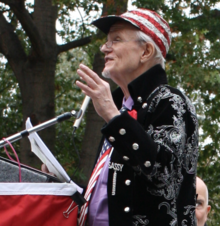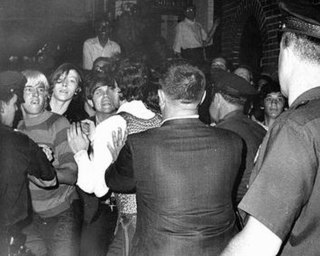
The Stonewall riots, also known as the Stonewall uprising, Stonewall rebellion, or simply Stonewall, were a series of protests by members of the LGBTQ community in response to a police raid that began in the early morning hours of June 28, 1969, at the Stonewall Inn in the Greenwich Village neighborhood of Lower Manhattan in New York City. Patrons of the Stonewall, other Village lesbian and gay bars, trans activists and unhoused LGBT individuals fought back when the police became violent. The riots are widely considered the watershed event that transformed the gay liberation movement and the twentieth-century fight for LGBT rights in the United States.
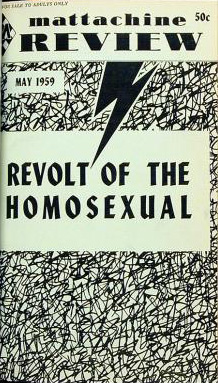
The Mattachine Society, founded in 1950, was an early national gay rights organization in the United States, preceded by several covert and open organizations, such as Chicago's Society for Human Rights. Communist and labor activist Harry Hay formed the group with a collection of male friends in Los Angeles to protect and improve the rights of gay men. Branches formed in other cities, and by 1961 the Society had splintered into regional groups.

Gay Liberation Front (GLF) was the name of several gay liberation groups, the first of which was formed in New York City in 1969, immediately after the Stonewall riots. Similar organizations also formed in the UK, Australia and Canada. The GLF provided a voice for the newly-out and newly radicalized gay community, and a meeting place for a number of activists who would go on to form other groups, such as the Gay Activists Alliance, Gay Youth New York, and Street Transvestite Action Revolutionaries (STAR) in the US. In the UK and Canada, activists also developed a platform for gay liberation and demonstrated for gay rights. Activists from both the US and UK groups would later go on to found or be active in groups including ACT UP, the Lesbian Avengers, Queer Nation, Sisters of Perpetual Indulgence, and Stonewall.

The gay liberation movement was a social and political movement of the late 1960s through the mid-1980s in the Western world, that urged lesbians and gay men to engage in radical direct action, and to counter societal shame with gay pride. In the feminist spirit of the personal being political, the most basic form of activism was an emphasis on coming out to family, friends, and colleagues, and living life as an openly lesbian or gay person.

Marsha P. Johnson was an American gay liberation activist and self-identified drag queen. Known as an outspoken advocate for gay rights, Johnson was one of the prominent figures in the Stonewall uprising of 1969.
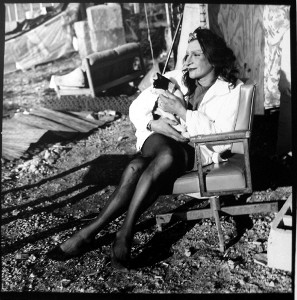
Sylvia Rivera was an American gay liberation and transgender rights activist who was also a noted community worker in New York. Rivera, who identified as a drag queen for most of her life and later as a transgender person, participated in demonstrations with the Gay Liberation Front.

The NYC Pride March is an annual event celebrating the LGBTQ community in New York City. The largest pride parade in North America and among the largest pride events in the world, the NYC Pride March attracts tens of thousands of participants and millions of sidewalk spectators each June. The parade route through Lower Manhattan traverses south on Fifth Avenue, through Greenwich Village, passing the Stonewall National Monument, site of the June 1969 riots that launched the modern movement for LGBTQ+ rights.
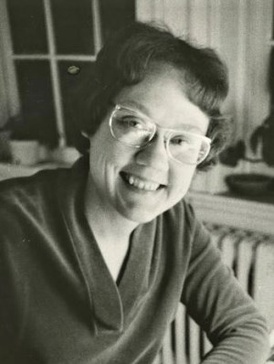
Barbara Gittings was a prominent American activist for LGBT equality. She organized the New York chapter of the Daughters of Bilitis (DOB) from 1958 to 1963, edited the national DOB magazine The Ladder from 1963 to 1966, and worked closely with Frank Kameny in the 1960s on the first picket lines that brought attention to the ban on employment of gay people by the largest employer in the US at that time: the United States government. Her early experiences with trying to learn more about lesbianism fueled her lifetime work with libraries. In the 1970s, Gittings was most involved in the American Library Association, especially its gay caucus, the first such in a professional organization, in order to promote positive literature about homosexuality in libraries. She was a part of the movement to get the American Psychiatric Association to drop homosexuality as a mental illness in 1972. Her self-described life mission was to tear away the "shroud of invisibility" related to homosexuality, which had theretofore been associated with crime and mental illness.
Street Transvestite Action Revolutionaries (STAR) was a gay, gender non-conforming and transvestite street activist organization founded in 1970 by Sylvia Rivera and Marsha P. Johnson, subculturally-famous New York City drag queens of color. STAR was a radical political collective that also provided housing and support to homeless LGBT youth and sex workers in Lower Manhattan. Rivera and Johnson were the "mothers" of the household, and funded the organization largely through sex work. STAR is considered by many to be a groundbreaking organization in the queer liberation movement and a model for other organizations.
This is a list of notable events in the history of LGBT rights that took place in the 1960s.

Katherine Lahusen was an American photographer, writer and gay rights activist. She was the first openly lesbian American photojournalist. Under Lahusen's art direction, photographs of lesbians appeared on the cover of The Ladder for the first time. It was one of many projects she undertook with partner Barbara Gittings, who was then The Ladder's editor. As an activist, Lahusen was involved with the founding of the Gay Activists Alliance (GAA) in 1970 and the removal of homosexuality from the American Psychiatric Association's Diagnostic and Statistical Manual of Mental Disorders (DSM). She contributed writing and photographs to a New York–based Gay Newsweekly and Come Out!, and co-authored two books: The Gay Crusaders in 1972 with Randy Wicker and Love and Resistance: Out of the Closet into the Stonewall Era, collecting their photographs with Diana Davies in 2019.

LGBT pride is the promotion of the self-affirmation, dignity, equality, and increased visibility of lesbian, gay, bisexual, and transgender (LGBT) people as a social group. Pride, as opposed to shame and social stigma, is the predominant outlook that bolsters most LGBT rights movements. Pride has lent its name to LGBT-themed organizations, institutes, foundations, book titles, periodicals, a cable TV channel, and the Pride Library.

Craig L. Rodwell was an American gay rights activist known for founding the Oscar Wilde Memorial Bookshop on November 24, 1967 - the first bookstore devoted to gay and lesbian authors - and as the prime mover for the creation of the New York City gay pride demonstration. Rodwell, who was already an activist when he participated in the 1969 Stonewall uprising, is considered by some to be the leading gay rights activist in the early, pre-Stonewall, homophile movement of the 1960s.
The Annual Reminders were a series of early pickets organized by gay organizations, held yearly from 1965 through 1969. The Reminder took place each July 4 at Independence Hall in Philadelphia and were among the earliest LGBT demonstrations in the United States. The events were designed to inform and remind the American people that gay people did not enjoy basic civil rights protections.
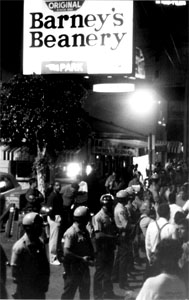
A zap is a form of political direct action that came into use in the 1970s in the United States. Popularized by the early gay liberation group Gay Activists Alliance, a zap was a raucous public demonstration designed to embarrass a public figure or celebrity while calling the attention of both gays and straights to issues of gay rights.

The Gay Liberation Monument is part of the Stonewall National Monument, which commemorates the Stonewall uprising of 1969. Created in 1980, the Gay Liberation sculpture by American artist George Segal was the first piece of public art dedicated to gay rights and solidarity for LGBT individuals, while simultaneously commemorating the ongoing struggles of the community. The monument was dedicated on June 23, 1992, as part of the dedication of the Stonewall National Monument as a whole.
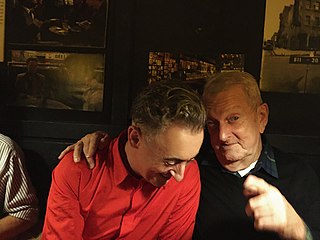
Richard Joseph Leitsch, also known as Richard Valentine Leitsch and more commonly Dick Leitsch, was an American LGBT rights activist. He was president of gay rights group the Mattachine Society in the 1960s. He conceptualized and led the "Sip-In" at Julius' Bar, one of the earliest acts of gay civil disobedience in the United States, LGBT activists used "sip-ins" to attempt to gain the legal right to drink in bars in New York. He was also known for being the first gay reporter to publish an account of the Stonewall Riots and the first person to interview Bette Midler in print media.

LGBT Pride Month, often shortened to Pride Month, is a month, typically June, dedicated to celebration and commemoration of lesbian, gay, bisexual, and transgender (LGBT) pride. Pride Month began after the Stonewall riots, a series of gay liberation protests in 1969.

Come Out! was an American LGBT newspaper that ran from 1969 to 1972. It was published by the Gay Liberation Front (GLF), a gay liberation group established in New York City in 1969, immediately following the Stonewall riots. The first issue came out on November 14, 1969, it sold for 35 cents, and 50 cents for outside of New York City. Its run only lasted for eight issues. Its tagline for the first paper was: "A Newspaper By And For The Gay Community".
